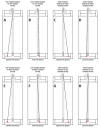Kinematic differences between left- and right-handed cricket fast bowlers during the bowling action
- PMID: 38249757
- PMCID: PMC10798611
- DOI: 10.17159/2078-516X/2023/v35i1a15144
Kinematic differences between left- and right-handed cricket fast bowlers during the bowling action
Abstract
Background: Despite differences between left- and right-handed athletes in other sports, minimal evidence exists regarding biomechanical similarities and differences between left- and right-handed cricket fast bowlers performing an equivalent task.
Objectives: This study aimed to compare the kinematics between left and right-handed fast bowlers performing an equivalent task (i.e. bowling 'over the wicket' to a batter of the same handedness as the bowler).
Methods: Full body, three-dimensional kinematic data for six left-handed and 20 right-handed adolescent, male, fast bowlers were collected using the Xsens inertial measurement system. Time-normalised joint and segment angle time histories from back foot contact to follow-through ground contacts were compared between groups via statistical parametric mapping. Whole movement and subphase durations were also compared.
Results: Left-handed players displayed significantly more trunk flexion from 49%-56% of the total movement (ball release occurred at 54%; p = 0.037) and had shorter back foot contact durations on average (0.153 vs 0.177 s; p = 0.036) compared to right-handed players.
Conclusion: Left- and right-handed bowlers displayed similar sagittal plane kinematics but appeared to use non-sagittal plane movements differently around the time of ball release. The kinematic differences identified in this study can inform future research investigating the effect of hand dominance on bowling performance and injury risk.
Keywords: biomechanics; dominance; handedness; laterality.
Conflict of interest statement
Conflict of interest and source of funding: The authors declare no conflict of interest and no source of funding.
Figures





Similar articles
-
Extrinsic and intrinsic factors associated with non-contact injury in adult pace bowlers: a systematic review protocol.JBI Database System Rev Implement Rep. 2015 Jan;13(1):3-13. doi: 10.11124/jbisrir-2015-1387. JBI Database System Rev Implement Rep. 2015. PMID: 26447003
-
Illegal bowling actions contribute to performance in cricket finger-spin bowlers.Scand J Med Sci Sports. 2018 Jun;28(6):1691-1699. doi: 10.1111/sms.13070. Epub 2018 Feb 27. Scand J Med Sci Sports. 2018. PMID: 29415324
-
A biomechanical comparison of conventional classifications of bowling action-types in junior fast bowlers.J Sports Sci. 2020 May;38(10):1085-1095. doi: 10.1080/02640414.2020.1741972. Epub 2020 Apr 12. J Sports Sci. 2020. PMID: 32281483
-
Injury Prevention Strategies for Adolescent Cricket Pace Bowlers.Sports Med. 2018 Nov;48(11):2449-2461. doi: 10.1007/s40279-018-0981-6. Sports Med. 2018. PMID: 30178303 Review.
-
Do Fast Bowlers Fatigue in Cricket? A Paradox Between Player Anecdotes and Quantitative Evidence.Int J Sports Physiol Perform. 2017 Jul;12(6):719-727. doi: 10.1123/ijspp.2016-0389. Epub 2016 Dec 14. Int J Sports Physiol Perform. 2017. PMID: 27967283 Review.
References
-
- Senington B, Lee RY, Williams JM. The use of inertial measurement units to identify biomechanical factors of performance in cricket fast bowlers. ISBS Proceedings Archive. 2022;40(1):632.
LinkOut - more resources
Full Text Sources
